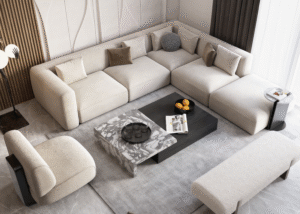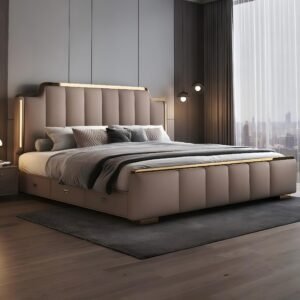A sofa is more than just a piece of furniture in your home; it’s a centerpiece that sets the tone for your living space, provides comfort for relaxation, and accommodates gatherings with family and friends. With a plethora of options available in the market, selecting the right home sofa can be a daunting task. This comprehensive guide aims to simplify the process, helping you make an informed decision that aligns with your needs, style, and budget.

1. Assess Your Needs and Space
Usage and Lifestyle
First, consider how you’ll use the sofa. If you have a large family or frequently host guests, a spacious sectional or a sofa with ample seating capacity would be ideal. For a small apartment or a cozy reading nook, a compact loveseat or a single – seater might suffice. Do you have kids or pets? Then, durability and easy – to – clean features should be high on your priority list. Leather or high – performance fabric sofas can withstand spills and scratches better than delicate materials.
Space Measurement
Before you start shopping, measure your living space accurately. Note the length, width, and height of the area where the sofa will be placed. Don’t forget to consider the doorways and hallways through which the sofa will need to pass during delivery. A sofa that looks perfect in the showroom but can’t fit into your home is a frustrating mistake. Also, think about the clearance around the sofa; there should be enough space to walk around it comfortably and open doors or drawers nearby.

2. Understand Sofa Styles
Modern and Minimalist
Modern sofas are characterized by clean lines, simple silhouettes, and a focus on functionality. They often feature neutral colors like white, gray, or black, and may incorporate metal or glass accents. These sofas work well in contemporary homes with a sleek, uncluttered aesthetic. For example, a low – profile modern sofa with a metal frame can add a touch of sophistication to a minimalist living room.

Traditional and Classic
Traditional sofas exude elegance and timeless charm. They typically have ornate details such as carved wood trim, tufted upholstery, and rolled arms. Rich colors like deep browns, burgundies, or classic neutrals are common. A traditional Chesterfield sofa, with its distinctive tufting and leather upholstery, can be a statement piece in a formal living room or a traditional – style home.

Scandinavian and Nordic
Inspired by the simplicity and functionality of Scandinavian design, these sofas prioritize comfort and natural materials. Light – colored wood frames, neutral or pastel – colored fabrics, and a focus on ergonomics are hallmarks of this style. A Nordic – style sofa with a wooden frame and a soft, linen – like fabric can create a warm and inviting atmosphere in a home, perfect for those who love a cozy, natural aesthetic.

Industrial and Rustic
Industrial sofas often feature exposed metal frames, reclaimed wood, and rugged fabrics like leather or denim. They bring a raw, edgy vibe to a space, ideal for lofts or homes with an industrial – inspired decor. Rustic sofas, on the other hand, use natural materials like solid wood and plush, earth – toned fabrics. A rustic sofa with a distressed wood frame and a cozy, knitted throw can add warmth to a cabin – style or country – themed home.

3. Evaluate Sofa Materials
Frames
The frame is the backbone of a sofa, so it’s crucial to choose a durable one. Solid wood frames, such as those made from oak, maple, or pine, are strong and long – lasting. Look for frames that are joined with mortise – and – tenon or dowel joints, as these provide better stability than nails or staples. Metal frames, usually made of steel, are also a durable option, especially for modern or industrial – style sofas. Avoid frames made of particleboard or plywood, as they can warp or break over time, especially with heavy use.

Upholstery Fabrics
Leather: Leather sofas are luxurious, durable, and easy to clean. Full – grain leather is the highest quality, offering a rich texture and developing a beautiful patina over time. Top – grain leather is also a good choice, being more affordable while still providing durability. However, leather can be prone to scratching and may not be the best option for homes with pets or young children.

Fabric: Fabric sofas come in a wide variety of colors, patterns, and textures. Cotton and linen are natural, breathable fabrics that offer a soft feel, but they can be prone to staining. Polyester blends are more durable and resistant to stains, making them a practical choice for families. Microfiber is another popular option, known for its softness, durability, and easy – to – clean properties. When choosing a fabric, consider the wear and tear it will endure; high – traffic areas require more durable fabrics.

Cushion Fillings
Foam: High – density foam is a common cushion filling, offering good support and durability. It retains its shape well over time, making it a suitable choice for those who prefer a firm seat. Memory foam cushions conform to the body, providing excellent comfort and pressure relief, but they can be more expensive.

Down and Feather: Down – filled cushions are incredibly soft and luxurious, offering a plush seating experience. However, they require regular fluffing to maintain their shape and can be more expensive. A blend of down and feathers, or down and foam, can provide a good balance of comfort and support.

Polyester Fiberfill: This is a more affordable cushion filling option. It’s soft but may flatten over time, so it’s best for occasional use or less – frequently used sofas.

4. Prioritize Comfort and Ergonomics
Sit on the sofa! This may seem obvious, but it’s essential to test the comfort level in person. Pay attention to the seat depth, seat height, and backrest support. The seat depth should allow you to sit with your feet flat on the floor and your knees at a comfortable angle. The seat height should be appropriate for easy getting in and out of the sofa. The backrest should support your spine naturally, without causing discomfort or strain.
If you prefer to lounge or watch TV on the sofa, consider one with adjustable headrests or reclining features. Some sofas also come with built – in lumbar support, which can be beneficial for those with back issues.

5. Customization Options
Many sofa manufacturers, like CSHome, offer customization options to meet your specific needs. You can choose the size, color, fabric, and even the configuration of the sofa. Need a sofa that fits perfectly in an awkward corner? Customize the dimensions. Want the sofa to match your living room’s color scheme exactly? Select a custom fabric or leather color. Some sofas can also be customized with additional features like built – in storage compartments or USB charging ports, adding functionality to your piece.
CSHome, with 16 years of experience in furniture manufacturing, understands the importance of customization. Our team of experts can work with you to create a sofa that not only meets your functional requirements but also reflects your personal style. Whether you need a traditional – style sofa for a classic home or a modern, minimalist design for a contemporary space, we can bring your vision to life.

6. Consider Durability and Longevity
A sofa is a significant investment, so you want it to last. In addition to choosing a durable frame and quality materials, look for sofas with a good warranty. A warranty can give you peace of mind, knowing that the manufacturer stands behind their product. Check the warranty details, including what is covered (frames, cushions, upholstery) and for how long.
Also, consider the maintenance requirements of the sofa. Leather sofas need regular conditioning to prevent drying and cracking, while fabric sofas may need periodic cleaning or stain protection treatments. Choosing a sofa that is easy to maintain can save you time and money in the long run.

7. Research and Compare Suppliers
Not all sofa suppliers are created equal. Do your research to find a reliable supplier with a good reputation for quality and customer service. Read online reviews, ask for recommendations from friends or family, and visit showrooms if possible. A reputable supplier will be transparent about their products, materials, and manufacturing processes.
CSHome has been a trusted name in the furniture industry for 16 years. We serve millions of families in over 80 countries, with a focus on providing high – quality, customizable sofas. Our manufacturing centers and expert team ensure that each sofa is built to last, and our commitment to customer service means we’re here to support you every step of the way, from design to delivery.

8. Balance Cost and Quality
Set a budget for your sofa purchase, but also be willing to invest in quality. A cheap sofa may save you money initially, but it may not last long or provide the comfort and support you need. On the other hand, an expensive sofa doesn’t always guarantee the best quality. Look for a balance between cost and quality, considering the factors we’ve discussed: frame durability, material quality, comfort, and customization options.
Remember that a good – quality sofa can enhance your living space for years to come, providing a comfortable and stylish place for you and your family to relax and enjoy.
In conclusion, choosing the right home sofa requires careful consideration of your needs, space, style, materials, comfort, and budget. By following this guide and working with a reputable supplier like CSHome, you can find the perfect sofa that transforms your living space into a cozy and inviting haven.





